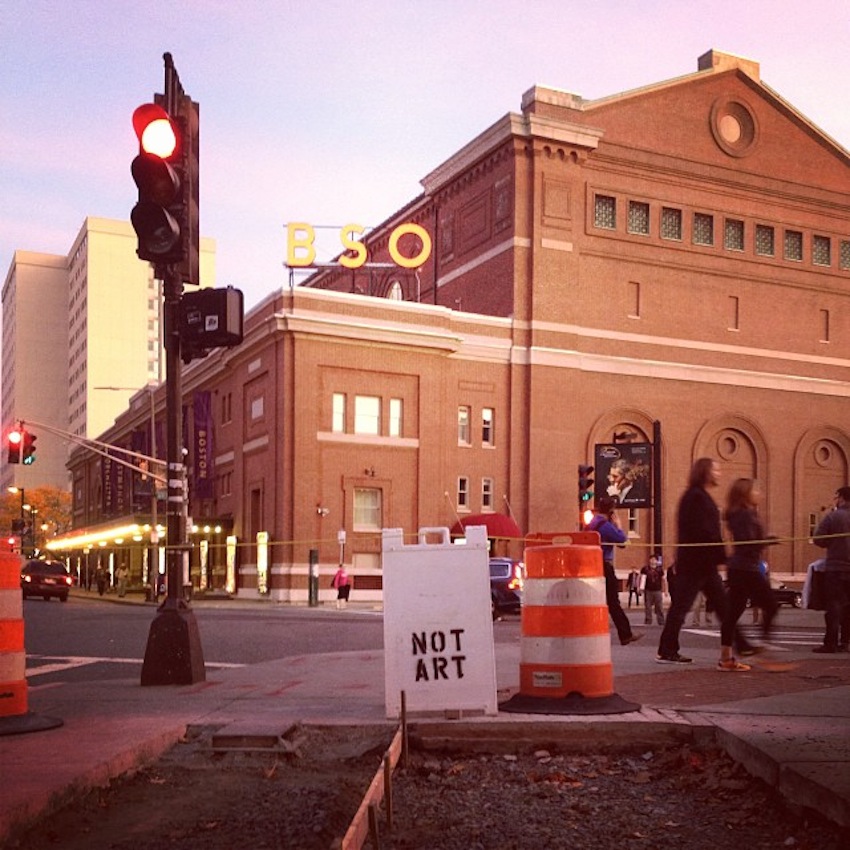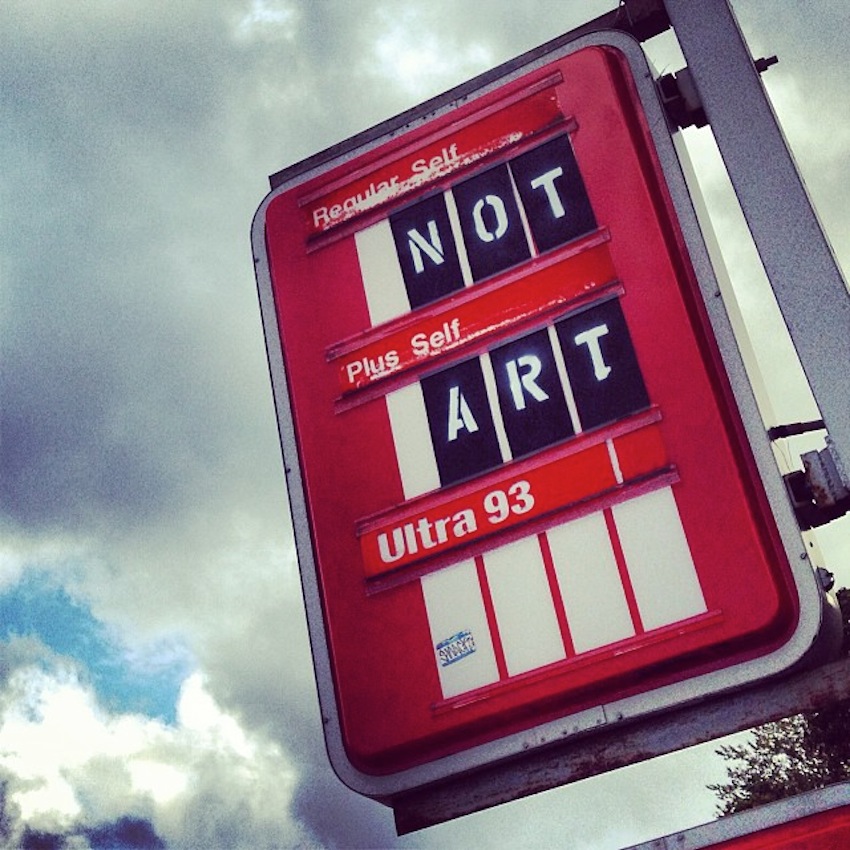The ‘Not Art’ Stencil Project Is Meant to Inspire ‘Wonder’

Not Art Photo Uploaded by PSD on Flickr
Some people view it as a message that calls attention to bland, often ignored objects in plain public view, while others have said that it’s pointless tagging that merely defaces local property.
But it’s that conversation between two sides of the argument, and the confusion that leaves people wondering what it means, that the creator of the “Not Art” stencil wants to happen in order to make a human connection based around his project.
“It creates this dialogue and gets people thinking. I feel like I have built something that works. I didn’t know if it was going to work at first, but it works,” said the Somerville resident behind the stenciling, who asked to remain anonymous.
The “Not Art” tag can be seen in numerous places in the Boston area, including along stretches of Mass. Ave. near MIT campus, emblazoned on construction signs in Back Bay, and splashed prominently on the abandoned gas station marquees near Somerville’s McGrath Highway.
In each setting, the artist said he relied on turning temporary objects—those found at construction sites or decrepit, abandoned pieces of property battered by the weather and left to decay—into the centerpiece for each individual artwork.
“I do it on things like the backs of road signs. It’s not going to destroy the purpose of the sign—it just doesn’t affect anything; it’s a temporary object. I have found a loophole in that,” he said. “It’s a found object. I leave it there, and mark it there, drawing some attention to it. These are things that usually have a rusty, old, weathered look that to me is just naturally beautiful. I don’t know why. I just find that beautiful. Some people can definitely appreciate the kind of textures I like to point out.”
But not everybody, of course.
Like any outdoor scribbles or unsolicited paintings, the “Not Art” tag has dug under the skin of some people that happen upon it.
As more of the graffiti has cropped up around Boston, Cambridge, and Somerville, arguments about whether or not this project defaces private property or merely brings life to bleak scenery, has exploded on Flickr, Reddit, and Instagram.
“Tagging in general is obnoxious. Sometimes, though, it’s redeemed by its artistic merit. This lacks that completely. Its ‘message’ might be clever enough for a high school art project, but in the real world, it’s just trite bullshit that’s fucking up the scenery,” one person argued on a long thread on Reddit, which picked apart the point of the concept.
The artist said it’s not about “pissing people off,” however. “Others might see it as a tag, and think of it as a tag. But it’s more about the surroundings that are near it that I want to draw attention to.”
And for some, that’s exactly what it has done.
Pedestrians who catch wind of the simple white or black lettering that marks the artist’s desired objects have noticed the irony of it all. “By pointing out the object that he claims is ‘not art,’ he makes it into art—his art,” one person said on the Reddit thread. “A simple form of irony is produced in which something is art only because it’s not art.”
But whether people think the “Not Art” tag is clever or another “obnoxious” act of vandalism done at the hands of some attention-seeking artist, everyone seems curious about what inspired the trend.
And no matter which side of the argument people seem to fall on, the artist remains pleased with the reaction that it’s been getting. “Any response to something is what an artist is looking for,” he said.

Photo via Facebook
What Is Not Art?
The idea for the “Not Art” stencil and graffiti started more than eight years ago, when the creator was waiting tables in Cambridge’s Central Square, an area prone to intricate examples of street art and murals dotting the alleyways between businesses.
After he brought in a conceptual piece of his artwork to his workplace, he became inspired by the reaction of the wait staff to create something that drudged up a range of responses all with an underlying theme: “What is it?”
The box full of charred wood and other “found objects” that he brought to work was partly inspired by Joseph Cornell, an artist in the 1950s through 1970s who would amass various items and arrange them inside glass boxes to put on display.
“I left [the box] at the waiter’s station, and I was going to show some coworkers. But it got busy, and I found out at the end of the night that co-workers picked it up and opened it and were like, ‘what the fuck is this?’ They totally, in their head, didn’t think it was art, necessarily,” he said. “One guy thought it was a Native American face painting kit. It was the best reaction to any art I had ever made. Another co-worker thought something was going to jump out. The reaction was amazing, and I wanted to replicate the reaction in the real world. It caught them off guard, it was out of context, and for them, in that moment, it was not art. My whole life I have been trying to do art, and it’s gotten nowhere, and I was like, ‘what if I don’t do art?’”
For years from there, the “Not Art” tag, which he refers to as “socially responsible graffiti,” was nothing more than some writing around his own apartment in the form of stencils and black marker being applied to inanimate objects laying around the house—something that eventually irked his roommate. “She liked my artwork in general, and we got along pretty well, but she hated this idea. She had such a passionate and strong response against it, I thought ‘this has to be something good.’”
So, he decided to take it outside.
“If you put the statement up that it’s not art, if it says it’s not art, art by nature is subjective, so it is art. I just went with it and made the stencil and started putting it around,” he said.
Over the years it casually evolved, and now it has reached a greater audience as social media has furthered the message. The artist has found his work has become the focus of a hashtag on Twitter and Instagram, with people snapping and sharing the graffiti regularly.
And of course, he has sifted through the comments on community boards like Reddit, closely monitoring the reactions his art has elicited.
“You can’t put anything in an art gallery to shock people. I can’t get the reaction I want within that context. The reaction I want is the reaction of wonder,” he said. “Wonder has a double entendre. I’m wondering what something is, but at the same time, people can say, ‘wow, it’s wonderful.’ And that’s the reaction I wanted.”

Photo Via Facebook
What’s Next For ‘Not Art’?
With people finally talking about the wording left behind on abandoned properties and in work zones around Boston, the artist has his eyes set on spreading the “Not Art” conversation out of state.
He said he feels as though he’s inundated his immediate surroundings with the concept of the project, and sometimes worries that if he’s caught in the act of applying his artwork around town, it could hinder the creative process.
The artist said he is totally “out there” for people to track him down—he even wears a jacket with “Not Art” spray-painted on it—but he wants to keep the mystery behind the project anonymous for now as he works to extend his reach and draw a similar response from passerby outside of his comfort zone.
“The next step is definitely Manhattan. I’ll take it to other cities, too. But Manhattan is definitely the next step,” he said. “Art to me is making a connection. It’s a human connection. The art is happening when people discuss it, and I want people to share that. Why not call that art?”


